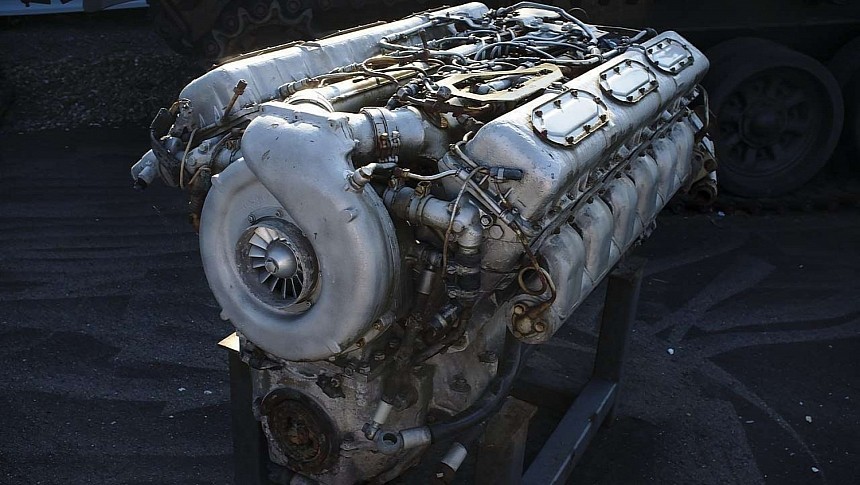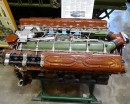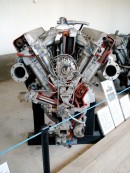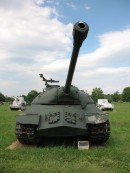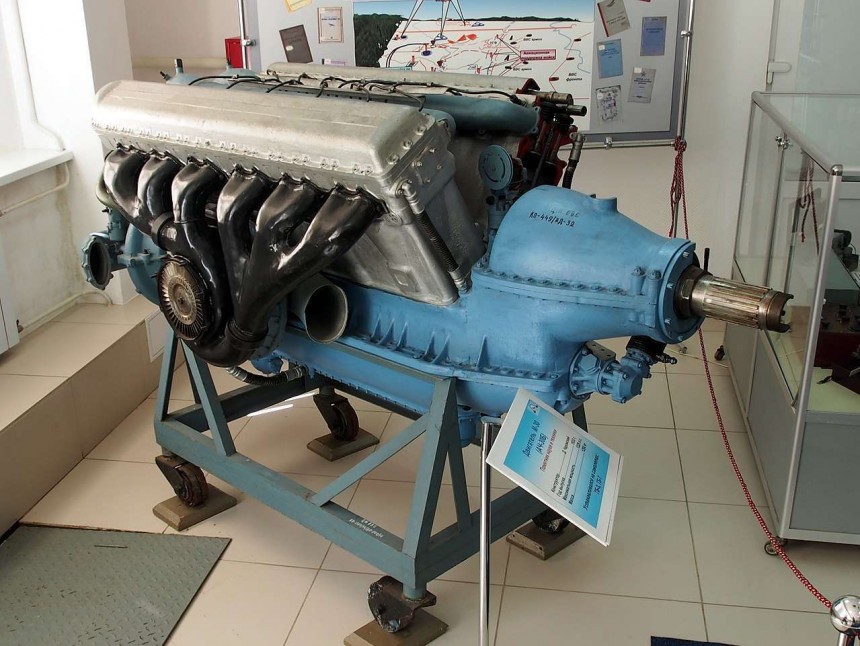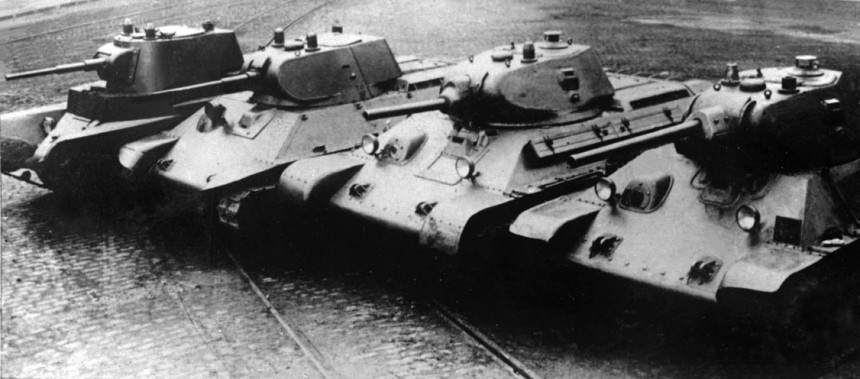Let us paint the scene for you. The day is September 1st, 1939, in the Soviet Union, and you're a middle-management engineer working at the Kharkiv Locomotive Factory in Ukraine. While a particular Austrian painter is busy imposing his will over Poland and seemingly safe from the onslaught thanks to a Molotov-Ribbentrop pact that Germany was totally going to abide by (not), a new tank engine has just rolled off the production lines. For better or worse, this engine would go on to define Soviet armor for decades.
This is the story of the Kharkiv V-2, the Russian V12 diesel tank engine that stuck around past World War II, the Cold War, and even into the earliest fringes of the 21st century. Of course, being Russia, so much of the V-2's existence is caked in layers of mystery, half-truths, and a liberal dose of propaganda. But to understand the impetus behind the V-2, we need to understand a little bit about what life was like for a tank engineer in the Soviet Union in the 1930s.
Of course, by 1931, a walrus-faced Georgian ex-bank robber named Joseph Stalin had already usurped full dictatorial control over the Soviet Union for nearly a decade. By concentrating the collective efforts of military contractors from across Russia, Ukraine, and all the Soviet satellite states, Joseph Stalin's goal of steeling itself against invaders from the West hung on the ability to mass produce powerful, reliable engines for their armored vehicles. Famously, the first vehicle built by the new Soviet Tank Bureau, the T-18 derived from the French Renault FT light tank, sported an engine with a paltry 35 horsepower. The later T-26 light tank, inspired by the old British Vickers Mark E, could only manage 90 horses.
When taking the more vital statistic of power-to-weight ratios into account, the T-26 could’ve kept up with early Panzer I and Panzer IIs but would’ve been a sitting duck against anything more advanced. Though not exactly a tank warfare expert himself, all military decisions still went across the desk of Stalin himself. Ultimately, it was decided that the diesel engine experts at Kharkiv Locomotive would be the ones who designed and supplied the Red Army with an engine to power the next generation of Soviet tanks. Under the leadership of Konstantin Chelpan, a Ukrainian-born engineer with Greek parents, the basic framework for what became the V-2 began to take shape.
Under Chelpan's leadership, the V-2 was designed with a large degree of lightweight aluminum alloy in mind, particularly in its engine block and crankcase. Though no big deal by modern standards, such technology in the 1930s was almost like witchcraft as far as the Red Army was concerned. Over time, a slightly asymmetrical piston stroke between the left and right cylinder banks was implemented with a stroke of 180 mm on the left-hand side and a 186.7 mm stroke on the right-hand side. This compensated for the intricate master-and-slave piston connecting rods on either side of the engine. Because of this, it was relatively easy for engineers to install each piston to the V-2's crankshaft, cutting down on turnaround time in the Kharkiv factory.
By 1938, it looked like Cheplan would have the V-2 ready for Red Army service by the end of the 1930s. While this would turn out to be true, Cheplan himself would not be around to see it. No sooner was Chelpan prepping to put the V-2 in production than a knock at his front door came from what was then known as the NKVD, the Soviet Secret Police. Citing his Greek heritage, Konstantin Chelpan was arrested under suspicion of anti-Soviet activity in December 1937. He was brutally tortured over the next three months before his execution on March 10th, 1938. Why? Well, because Stalin, of course.
In Chelpan's absence, a consortium of two of his understudies, Ivan Yakovlevich Trashutin and Yakov Efimovich Vikhman, worked tirelessly to complete their old boss's grand plan. With the V-2's complex closed water-cooling system nearing completion and its gargantuan 38.8 liters (2,367.7 cu in) of displacement now set in stone, it wouldn't be long before these hulks of engines were shoehorned into Soviet armor. The first pre-production V2 left the factory floor in late 1937. Its first application was in the BT-7M variant of the famous BT series of Soviet light tanks famous for their Christie suspension designed by an American of all people.
Though the notion the V-2 began production the day German bombs started falling over Poland is likely total propaganda, it can't be argued the engine wasn't ready for action come the time the Wehrmacht and Waffen SS predictably ripped the Molotov-Ribbentrop pact to shreds with Operation Barbarossa. Of course, the Soviet defense of Barbarossa was the wide-scale operational debut of the V-2's most iconic pairing, the T-34. Inspired in large part by observing the progress German tanks were making in the early days of the National Socialist regime, it was Stalin himself who gave his blessing to the T-34 to bear the brunt of the German armored onslaught.
The T-34 was far from perfect; its optics were notoriously shoddy and weren't redesigned until later in the war. There are even stories of German armor maneuvering around a column of T-34s and blowing them to pieces without the drivers having a clue where the blow came from. Only when Soviet tanks started blowing up around them did they frantically scatter. The fact the tank's commander also had to fire the gun in these early days is a design flaw that cost lives in combat. This issue with the commander wasn't fully corrected until the T-34-85 introduced a 3rd crewman, a dedicated gunner, into the turret in 1944. Lord only knows what happened to the engineer who made that blunder when Old Man Joseph was made aware.
In truth, if the American M4 Sherman was a Cadillac, and many were built in Cadillac factories after all, the T-34 was a Lada Riva. But through it all, the Kharkiv V-2 proved to be something of a superstar in service. Though not perfect by any stretch either, any Red Army soldier familiar with fixing tractor engines stood a good chance of fixing a V-2 out in the field. But even so, the Germans were stopped just short of reaching Moscow, and the T-34 was there to milk all the credit. With that said, the T-34's traits certainly endeared itself to the archetypically Soviet philosophy of keeping things rugged and simple in regard to not just machines of war but life in general, a uniquely Russo-Soviet quality generally referred to as smekalka.
Smekalka loosely translates to "the ability to deal with non-trivial situations or problems," in Russian. Whether this line of thinking is the Soviet equivalent of obnoxious American patriotism is beside the point. What mattered is that the Red Army fell head over heels in love with the V-2's architecture. The engine was promptly used in the SU-85 self-propelled gun and the SU-100 tank destroyer in the same outfit as the T-34. Upgraded variants with reinforced cylinder heads and beefier fuel pumps would soon make their way to the IS line of heavy tanks. Some later variants, like the IS-4, were even fitted with superchargers to bump their performance up to 700 horsepower. But through the Second World War, the V-2 could always be relied on to make between 450 and 600 horsepower.
Even well into the Cold War, the V-2's basic architecture with incremental improvements has featured on everything from the T-10 heavy tank (V-12-5), the T-54/T55 (V-54/55), arguably the first Soviet main battle tank, and so many Soviet MBTs henceforth like the T-62 (V-55V), T-72 (V-84), and even the downright contemporary T90A and T-90M under the designation V-92. The same applies to the plethora of different armored vehicles, from self-propelled guns and tank destroyers to armored tractors, which all shared Soviet main battle tank DNA. There are even unconfirmed reports of a modernized V-2 variant powering Russia's 21st century MBT, the T-14 Armata, though others say it's the bonkers 12N360 X-12 engine.
Regardless, it's hard to say the Soviets, Russians, and even the Ukrainians didn't manage to squeeze more life out of one tank engine than any other nation. Though the American Abrams tank, perpetually at odds with Russian armor, sports jet turbine engine propulsion, it's safe to say a Honeywell AGT1500 isn't as easy to repair in the field as the T90M's absolute dinosaur of an engine. It's a trivial victory, granted.
But in a history of tank warfare riddled with great engines, the V-2 stands on its own in longevity. Up until a T-72 launches its turret into the stratosphere on Telegram for the umpteenth time, at least.
Of course, by 1931, a walrus-faced Georgian ex-bank robber named Joseph Stalin had already usurped full dictatorial control over the Soviet Union for nearly a decade. By concentrating the collective efforts of military contractors from across Russia, Ukraine, and all the Soviet satellite states, Joseph Stalin's goal of steeling itself against invaders from the West hung on the ability to mass produce powerful, reliable engines for their armored vehicles. Famously, the first vehicle built by the new Soviet Tank Bureau, the T-18 derived from the French Renault FT light tank, sported an engine with a paltry 35 horsepower. The later T-26 light tank, inspired by the old British Vickers Mark E, could only manage 90 horses.
When taking the more vital statistic of power-to-weight ratios into account, the T-26 could’ve kept up with early Panzer I and Panzer IIs but would’ve been a sitting duck against anything more advanced. Though not exactly a tank warfare expert himself, all military decisions still went across the desk of Stalin himself. Ultimately, it was decided that the diesel engine experts at Kharkiv Locomotive would be the ones who designed and supplied the Red Army with an engine to power the next generation of Soviet tanks. Under the leadership of Konstantin Chelpan, a Ukrainian-born engineer with Greek parents, the basic framework for what became the V-2 began to take shape.
Under Chelpan's leadership, the V-2 was designed with a large degree of lightweight aluminum alloy in mind, particularly in its engine block and crankcase. Though no big deal by modern standards, such technology in the 1930s was almost like witchcraft as far as the Red Army was concerned. Over time, a slightly asymmetrical piston stroke between the left and right cylinder banks was implemented with a stroke of 180 mm on the left-hand side and a 186.7 mm stroke on the right-hand side. This compensated for the intricate master-and-slave piston connecting rods on either side of the engine. Because of this, it was relatively easy for engineers to install each piston to the V-2's crankshaft, cutting down on turnaround time in the Kharkiv factory.
In Chelpan's absence, a consortium of two of his understudies, Ivan Yakovlevich Trashutin and Yakov Efimovich Vikhman, worked tirelessly to complete their old boss's grand plan. With the V-2's complex closed water-cooling system nearing completion and its gargantuan 38.8 liters (2,367.7 cu in) of displacement now set in stone, it wouldn't be long before these hulks of engines were shoehorned into Soviet armor. The first pre-production V2 left the factory floor in late 1937. Its first application was in the BT-7M variant of the famous BT series of Soviet light tanks famous for their Christie suspension designed by an American of all people.
Though the notion the V-2 began production the day German bombs started falling over Poland is likely total propaganda, it can't be argued the engine wasn't ready for action come the time the Wehrmacht and Waffen SS predictably ripped the Molotov-Ribbentrop pact to shreds with Operation Barbarossa. Of course, the Soviet defense of Barbarossa was the wide-scale operational debut of the V-2's most iconic pairing, the T-34. Inspired in large part by observing the progress German tanks were making in the early days of the National Socialist regime, it was Stalin himself who gave his blessing to the T-34 to bear the brunt of the German armored onslaught.
The T-34 was far from perfect; its optics were notoriously shoddy and weren't redesigned until later in the war. There are even stories of German armor maneuvering around a column of T-34s and blowing them to pieces without the drivers having a clue where the blow came from. Only when Soviet tanks started blowing up around them did they frantically scatter. The fact the tank's commander also had to fire the gun in these early days is a design flaw that cost lives in combat. This issue with the commander wasn't fully corrected until the T-34-85 introduced a 3rd crewman, a dedicated gunner, into the turret in 1944. Lord only knows what happened to the engineer who made that blunder when Old Man Joseph was made aware.
Smekalka loosely translates to "the ability to deal with non-trivial situations or problems," in Russian. Whether this line of thinking is the Soviet equivalent of obnoxious American patriotism is beside the point. What mattered is that the Red Army fell head over heels in love with the V-2's architecture. The engine was promptly used in the SU-85 self-propelled gun and the SU-100 tank destroyer in the same outfit as the T-34. Upgraded variants with reinforced cylinder heads and beefier fuel pumps would soon make their way to the IS line of heavy tanks. Some later variants, like the IS-4, were even fitted with superchargers to bump their performance up to 700 horsepower. But through the Second World War, the V-2 could always be relied on to make between 450 and 600 horsepower.
Even well into the Cold War, the V-2's basic architecture with incremental improvements has featured on everything from the T-10 heavy tank (V-12-5), the T-54/T55 (V-54/55), arguably the first Soviet main battle tank, and so many Soviet MBTs henceforth like the T-62 (V-55V), T-72 (V-84), and even the downright contemporary T90A and T-90M under the designation V-92. The same applies to the plethora of different armored vehicles, from self-propelled guns and tank destroyers to armored tractors, which all shared Soviet main battle tank DNA. There are even unconfirmed reports of a modernized V-2 variant powering Russia's 21st century MBT, the T-14 Armata, though others say it's the bonkers 12N360 X-12 engine.
Regardless, it's hard to say the Soviets, Russians, and even the Ukrainians didn't manage to squeeze more life out of one tank engine than any other nation. Though the American Abrams tank, perpetually at odds with Russian armor, sports jet turbine engine propulsion, it's safe to say a Honeywell AGT1500 isn't as easy to repair in the field as the T90M's absolute dinosaur of an engine. It's a trivial victory, granted.
